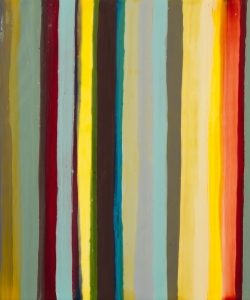Jasper Johns said that he chose subjects from “things the mind already knows,” which allowed him to focus on the act of painting. Limiting my recent series to stripes is similar in intent. In orienting my stripes vertically, I am trying avoid possible associations with landscape that horizontal bands might have. I prefer my stripes to stand on their own merit — stripe for stripe’s sake. In my initial work as a “striper,” I modulated tones so as to hover in greys, reining in extremes of warmth and coolness. A brighter tone might even serve to reinforce the muted and circumspect quality of my palette, rather than conjuring a particular object or feeling.
With my Eurythmic series, I eased my restraint and introduced bright high notes to the base of grayish low notes, resulting in effects of punctuation and tempo. These stripes were meant to sing rather than just converse together. My selections were intuitive and not according to a system. Perhaps this may elicit outside references for viewers, but I like to think of these paintings as visual rhythms with their own individual harmonic vibration. Seeing a rhythm in contrast to hearing a rhythm is very interesting to me, and I don’t intend any correspondence to musical notes or notation.
The Eurythmic series is a reductionist’s visual idea of harmony. One stripe is next to another — each with a different value and thickness but with a sense of variety within repetition. Is the stripe straight or is there a slight of hand in the stripe where I had a split second of no control and the stripe veers a little? The weave that holds the stripes together is my hand in the act of painting. “Hand” here means everything from the actual physical holding of the brush loaded with paint being pulled across a panel to the psychic part that is the artist’s unique culmination of their life experience informing each choice of color and type of brushstroke. It’s about fluidity that comes by rendering freely a soft edged stripe.








